Faced with a new generation of fine wine buyers seeking more of the “weird and wonderful”, let alone recent economic obstacles – Coronavirus keeping drinkers off the streets, US tariffs on European wines – Bordeaux can struggle to find space to thrive.
Bordeaux’s traditional image compared to more fashionable regions such as Burgundy, Piedmont, or Champagne means its prices are lagging behind. The silver lining is that Bordeaux appears excellent value for the high quality available in comparison.
Wine Lister’s dynamic buy recommendation tool currently identifies 219 Bordeaux wines as MUST BUYs – just 19 fewer than the original MUST BUY list from September 2019.
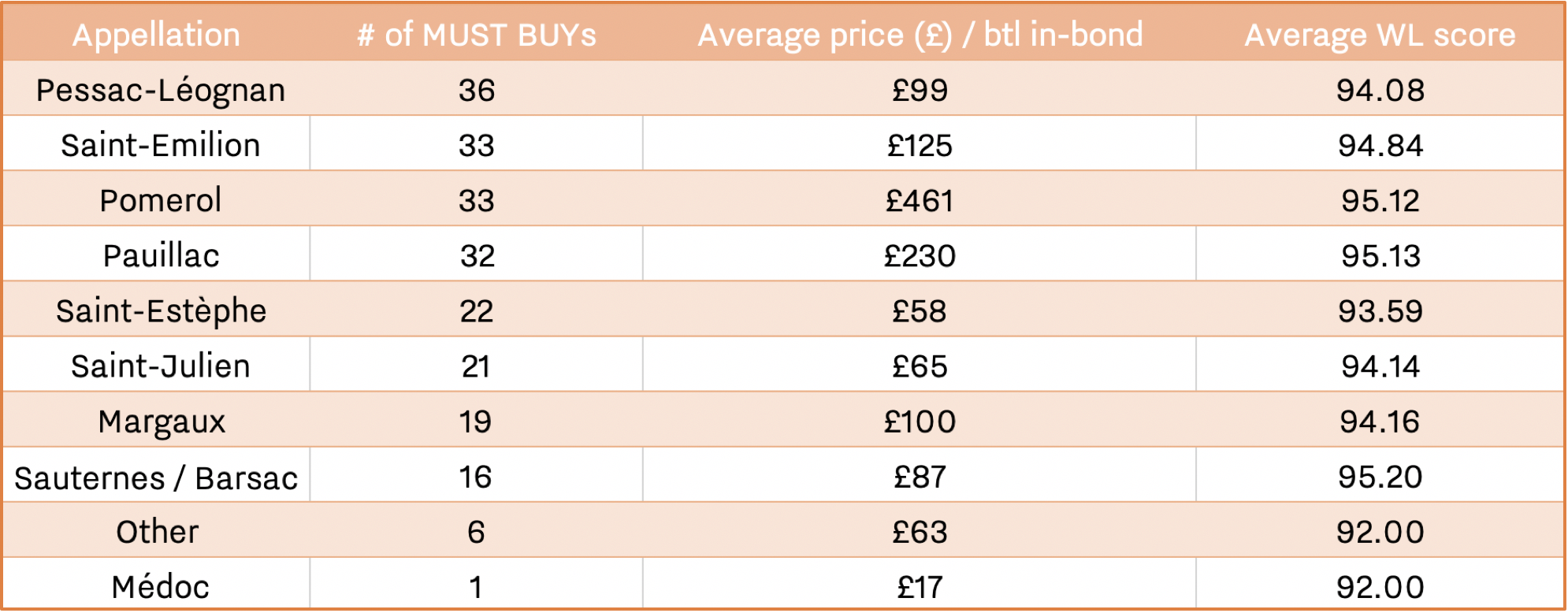
The above table shows each Bordeaux appellation by number of MUST BUYs, as well as average price and WL score of each MUST BUY appellation group. Marking the delayed opportunity presented by slow price evolution post-en primeur, 2016 is the most-featured vintage, achieving 40 entries out of the 219 Bordeaux MUST BUYs (or 18%).
Leading MUST BUY appellation Pessac-Léognan is made up of 28 reds and eight dry whites. Producer Domaine de Chevalier features particularly heavily, earning MUST BUY status for 1981, 2009, 2014, 2015, and 2018 for its red wine, and 2004, 2009, 2010, and 2013 for white. Its second red wine, L’Esprit de Chevalier, appears for the 2016 vintage.
Smith Haut Lafitte and La Mission Haut-Brion share the remaining white places between them, while Haut-Bailly, Haut-Brion, Latour-Martillac, and Malartic-Lagravière achieve multiple entries for reds only. Price-rising superstar Les Carmes Haut Brion features for just one vintage – the 2017.
Right bank appellations Saint-Emilion and Pomerol share second place, with 33 MUST BUYs each. They both earn slightly better average WL scores than Pessac-Léognan, but at prices 26% and 366% higher respectively on average than Pessac counterparts.
The large price difference is hardly surprising in Pomerol, given that its MUST BUY hoard includes five vintages of Petrus, and one of Le Pin. Without these, the average price of Pomerol MUST BUYs is £171, and there are still options at the more affordable end (such as 2016 Vray Croix de Gay).
Powerhouse Pauillac comes next, and includes 14 first growth entries. Mouton takes the lion’s share of these, featuring seven vintages from 1996-2018. Latour earns five places (including one much older vintage – 1964), and Lafite two. Pichon Comtesse also features heavily, earning five MUST BUYs for its grand vin, and one for the Réserve de la Comtesse.
In terms of pure value for money, the one MUST BUY from the Médoc appellation – Potensac 2018 – wins out, followed more generally by Saint-Estèphe’s 22 MUST BUY entries. Perhaps unsurprisingly, its crowned king is Calon Ségur, earning MUST BUY status for five vintages – 2005, 2009, 2014, 2015, and 2016.
Explore all 219 Bordeaux MUST BUYs here.
This week Wine Lister published its first in-depth study of 2020, focusing on the leading wines and producers of Piedmont.
The key takeaways from the report prove Piedmont to be somewhat of an enigmatic region, earning high praise from critics, and experiencing strong long- and short- term price performance, while still lagging behind in terms of consumer popularity.
While this is perhaps a consequence of Nebbiolo’s relative obscurity when compared with international grape varieties, Piedmont’s unique position – a veritable treasure trove of gems to uncover – presents a real opportunity both for vinous discovery and future value.
Wine Lister Pro members can read the full Piedmont report here. All free users can purchase the report for £200 from Wine Lister’s Analysis page.
Below we examine the top Barolos and Barbarescos by WL score.
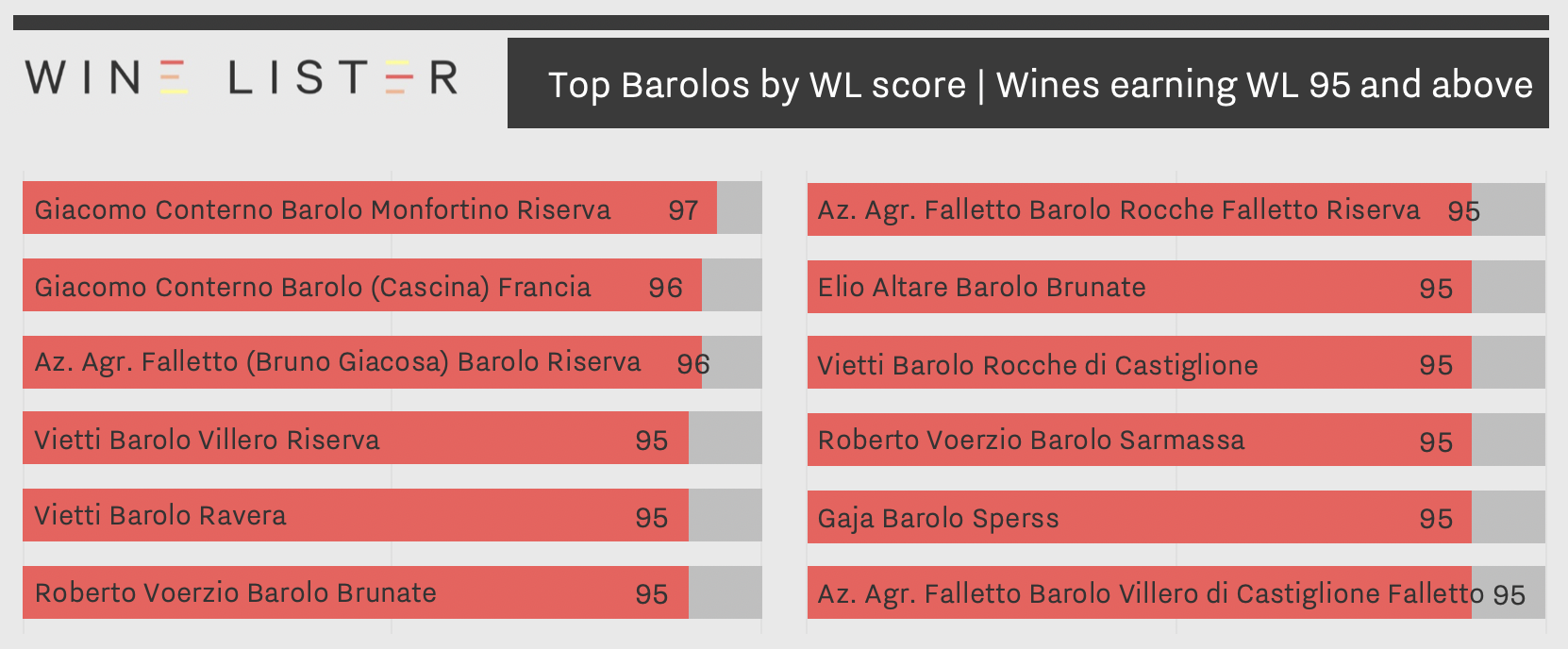
Giacomo Conterno takes both first and second places in the ranking of Barolos by WL score. The icon wine, Barolo Monfortino Riserva is the only Piedmont wine to earn a WL score of 97, while the Barolo Francia shares its score of 96 with the Barolo Riserva from the legendary Bruno Giacosa’s négociant outfit, Azienda Agricola Falletto, as well as the two highest-scoring Barbarescos (see below).
While earning joint-second place for the straight Barolo Riserva, Falletto also features for two site-specific bottlings, the Barolo Rocche Falletto Riserva and Barolo Villero di Castiglione Falleto, making the renowned house the joint-most prolific producer in the top Barolo rankings shown. It shares this position with Vietti, which earns WL 95 for its Villero Riserva, Ravera, and Rocche di Castiglione Barolos.
Elio Altare’s Barolo Brunate is the most reasonably priced of these top 12 Barolos, with an average price of £112 per bottle in-bond (when purchased by the case). Both of Roberto Voerzio’s highest-scoring wines, the Sarmassa and Brunate, follow with average prices of £152 and £165 respectively.

Eight Barbarescos achieve a WL score of 95 or above. The appearance of multiple wines per producer is accentuated here, with Roagna and Gaja earning three places apiece, followed by two Barbarescos from Falletto (totalling seven wines in Falletto’s hoard of WL scores of 95 and above).
Both sets of rankings provide useful leads in terms of producers to look out for, particularly heading into further releases of Barolo’s latest vintage, 2016, in the spring. For more specific recommendations of further Piedmontese wines and back vintages, see the region’s full list of MUST BUYs, and / or Piedmont’s Hidden Gems.
With Burgundy en primeur coming to a close – and such a good array of 2018s to choose from at that – fine wine collectors might feel inclined to tighten their purse strings over the coming months (perhaps until the next big campaign to come – Bordeaux 2019 en primeur). For those unable to resist the temptation of continuing to grow their wine collection, the Rhône is a perfect resting place for high-quality drinking wines.
This week we focus on a subset of Rhône MUST BUYs – those under £100 per bottle in-bond (when bought by the case), with WL scores above 95, of which there are 36.
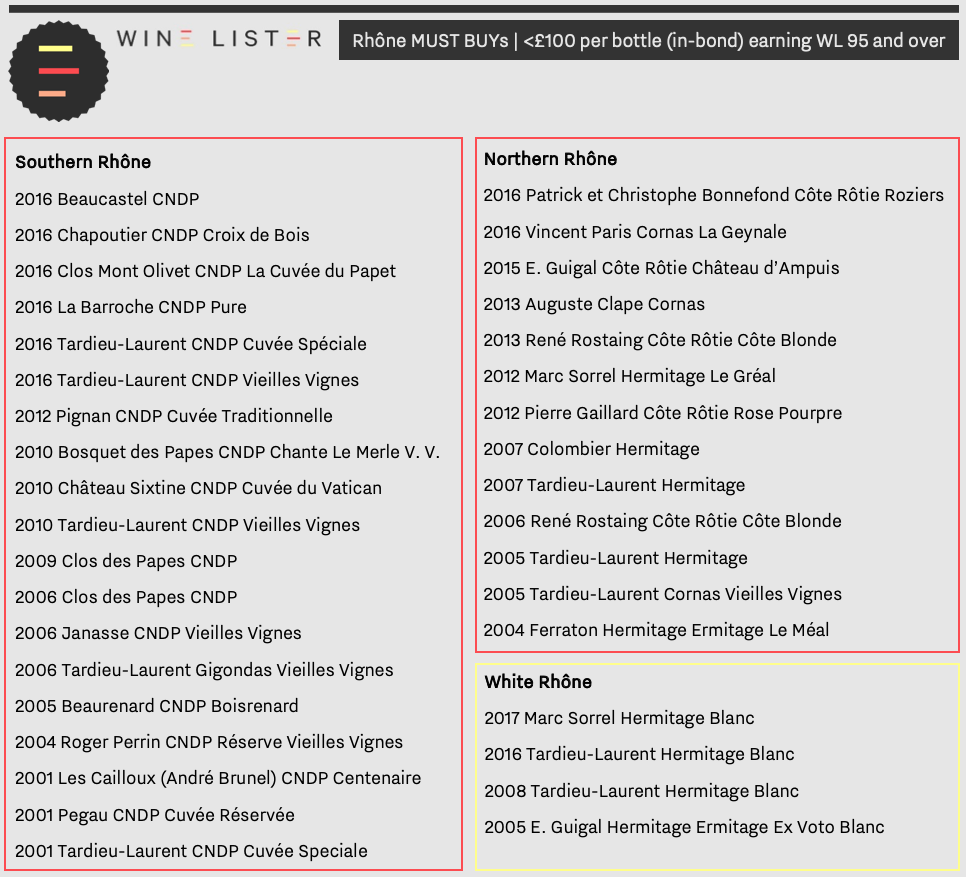
Châteauneuf-du-Pape wins the lion’s share of top Rhône MUST BUYs under £100, with 18 entries across eight different vintages. The exceptional 2016 vintage features heavily, however for wines drinking now, 2005 Beaurenard’s CNDP Boisrenard or 2009 Clos des Papes’ CNDP are particularly interesting options.
Hermitage too fairs well, with five reds and all four whites. Value Picks 2007 Colombier Hermitage and 2004 Ferraton Ermitage Le Méal provide impressive quality and bottle age for just £33 and £35 per bottle in-bond respectively (if you can get your hands on any).
Côte Rôtie matches in number for reds, and features Hidden Gem 2012 Côte Rôtie Rose Pourpre from Pierre Gaillard, which Wine Lister partner critic, Jancis Robinson, awards 18 points, commenting, “No doubt this is a very special cuvée”.
A consistent feature throughout is Maison Tardieu-Laurent – a powerhouse producer of reference for quality matched by exceptional value in the Rhône.
See the selection of Rhône MUST BUYs featured above here, or browse the full MUST BUY selection.
Earlier this week, we explored Wine Lister’s top red Value Picks (wines with the best quality-to-price ratios of all those in the Wine Lister database), noting that Tuscany and Bordeaux are the two best regions for value overall.
Having seen a noticeable lack of red Value Picks in Burgundy, the region’s white wines perform much better for quality-to-price ratio. The chart below shows the top eight regions for white Value Picks, and their average price per region.
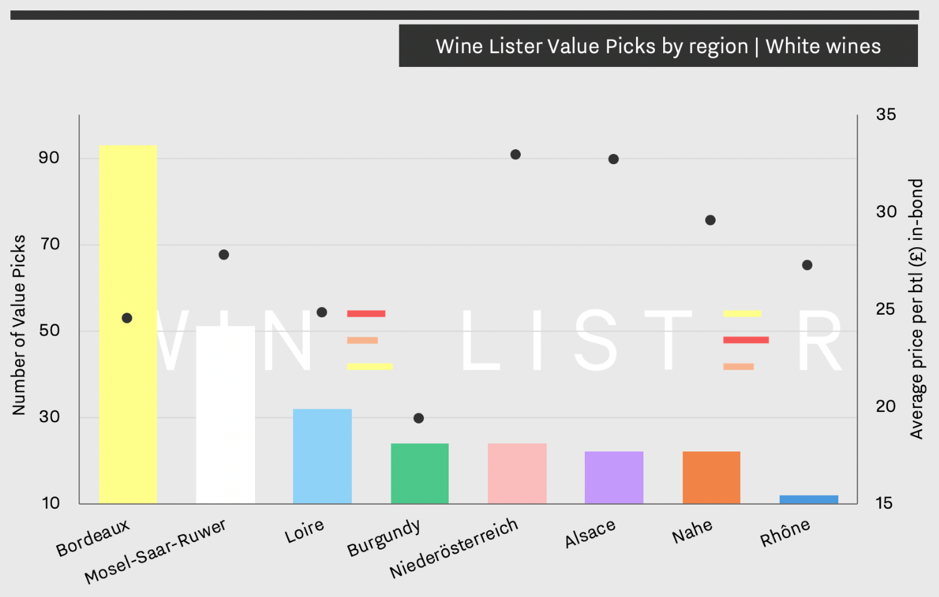
Of the 280 white Value Picks shown above, Bordeaux and the Mosel are heavily represented, in most part due to the impressive quality-to-price ratio of their sweet (or semi-dry) wines. Indeed, whites from Sauternes and Barsac make up all but one of the Bordeaux white Value Picks. While not the “most popular” these are some of the oldest Value Picks on Wine Lister, and include examples such as 1995 Clos Haut-Peyraguey, and 1996 Nairac.
The Loire provides a mix of different sweetness levels, however those achieving the highest quality are also sweet (such as 2006 Domaine Huet Clos du Bourg Moelleux).
Treading into Riesling-land, the Mosel and Nahe offer up the likes of Joh. Jos Prüm’s Wehlener Sonnenuhr Riesling Auslese Goldkapsel, and Dönnhoff’s Oberhäuser Brucke Riesling Auslese Goldkapsel. Alsace and Austria’s Niederösterreich produce some gems too (from the likes of Zind-Humbrecht and F.X. Pichler respectively), though of all white Value Picks these two regions are the most expensive on average.
Burgundy achieves 24 white Value Picks, the majority of which come from Chablis – the appellation which historically renders the best value for Burgundian whites. Other white Value Picks of note are Patrick Javillier’s Meursault Les Tillets, and Paul Pillot’s Chassagne-Montrachet Clos Saint-Jean.
See all white Value Picks here.
With Burgundy 2018 en primeur in full swing, soaring prices for some of Burgundy’s best can add to the January blues. While Burgundy prices tend to rise more quickly after release than any other region (making the en primeur buying system therefore extremely worthwhile), other regions provide better sources of good value wines for drinking, rather than cellaring for future consumption. To wave goodbye to any remaining blues as January come to a close, Wine Lister therefore looks this week at Value Picks from across fine wine regions.
Wine Lister’s Value Pick algorithm simply flags wines with the best quality-to-price ratios of all the wines in our database. A coefficient is applied to allow exceptional quality to be recognised, even for higher-priced wines.
The chart below shows the top nine regions for red Value Picks, and their average price per region.
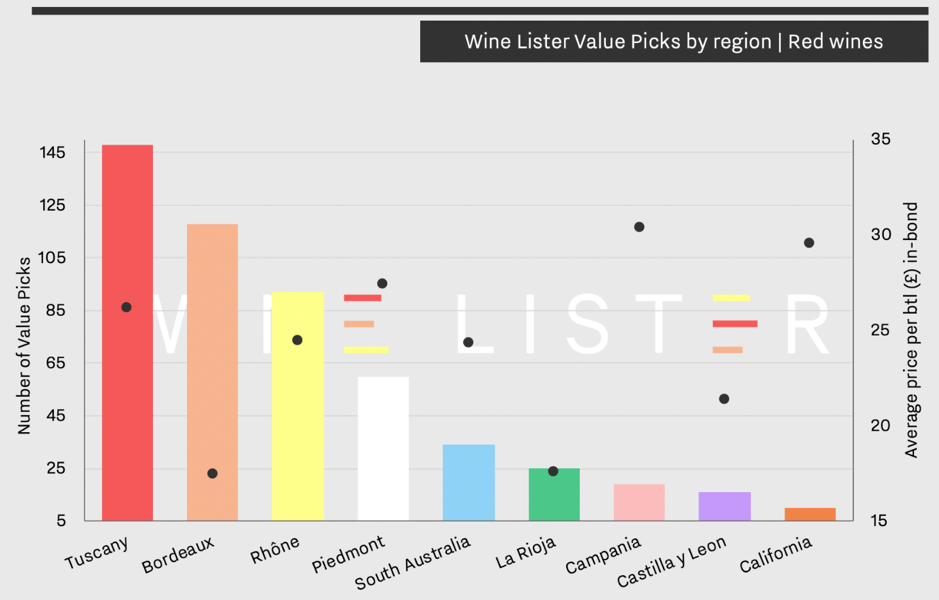
Italy takes the lead for number of best-value wines overall, with 227 Value Picks from across three regions – Tuscany, Piedmont, and Campania. Indeed, the top 10 Value Picks by WL score all hail from Tuscany, with wines such as Fontodi’s Chianti Classico Vigna del Sorbo Riserva, Isole e Olena’s Collezione Privata Syrah, and Castello dei Rampolla’s Sammarco making the cut.
Piedmont does not go wanting for Value Picks, with a wide range of suggestions, from Domenico Clerico’s Barolo Ciabot Mentin to Vietti’s Langhe Nebbiolo Perbacco.
France also does well for Value Picks, with 210 reds entries between Bordeaux and the Rhône. The former region has the lowest average price of all Value Pick regions shown above (£17.47 per bottle in-bond – when buying a full case), and includes Crus Classés from across appellations such as Malartic-Lagravière Rouge and Grand Mayne, as well as some second wines of Grands Crus châteaux (e.g. Pichon Comtesse’s Réserve de la Comtesse, and La Dame de Montrose).
The Rhône is home to 93 Value Picks from both north and south, and provides a list particularly strong in back vintages. Entries include Ferraton’s Hermitage Les Dionnières 2004, and Clusel Roch’s Côte Rôtie 2009.
The new world is well-represented by Value Picks from Australia across the McLaren Vale and Barossa Valley. California also makes an appearance, although perhaps expectedly, its 10 Value Picks earn the highest average price of any region shown in the chart above.
Search through all red Value Picks here.
Burgundy is, quite noticeably, missing from the top red Value Picks chart. It achieves just four in total: 2002 Joseph Drouhin Gevrey-Chambertin, 2003 Confuron-Cotetidot Echezeaux, 2017 Bertrand Ambroise Nuits-Saint-Georges, and 2007 Bouchard Volnay Clos des Chênes. However, Burgundy is much more present for whites – watch this space for white Value Picks later in the week.
Since its launch in September, Wine Lister’s MUST BUY list has unveiled fine wines across multiple regions, vintages, price points, and drinking occasions, all with the common theme of being so good, that they simply must find their place in fine wine fanatics’ cellars. Wine Lister’s prices are updated weekly, and since price (in the form of value) plays a major part in the MUST BUY algorithm, MUST BUYs too will henceforth be updated weekly.
Since its last update, the MUST BUY list has grown by four wines (to 1,697), with 22 new entries, and 18 wines that have fallen off the list. Following the same trend as last week, nine out of the 22 new MUST BUYs (or 41%) are Burgundian. Big names in Burgundy continue to do well, with three new white Buzz Brands hailing from Raveneau, Jean-François Coche-Dury, and Pierre Yves Colin-Morey respectively.
Elsewhere within white entries are two Rieslings, the Alsatian Hidden Gem, Albert Mann’s l’Epicentre 2008, and the indomitable Joh. Jos Prüm’s Wehlener Sonnenuhr, whose 2011 is now one of seven MUST BUY vintages of this sensational Value Pick.
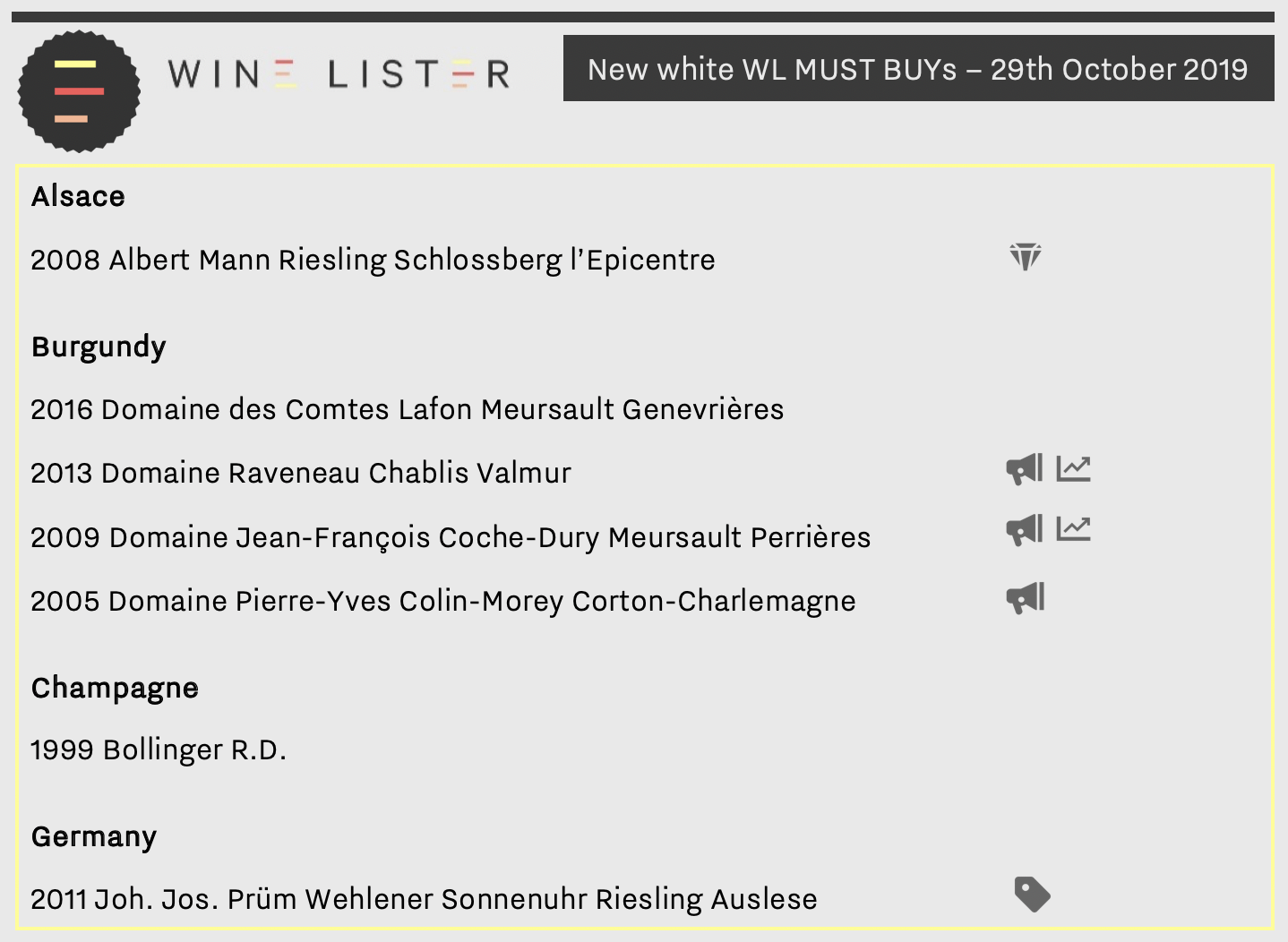
With the clocks turned back and a wintry chill in the air, there are twice as many new red MUST BUYs as white. Burgundy and Italy make the strongest showing, with five reds apiece. Maison Joseph Drouhin sees the addition of its Chambolle-Musigny Les Baudes 2008, bringing the house’s MUST BUY total to 21 wine vintages. Meanwhile Italy’s new MUST BUYs hail from four big name growers: Gaja, Roberto Voerzio, Castello di Ama, and Isole e Olena.
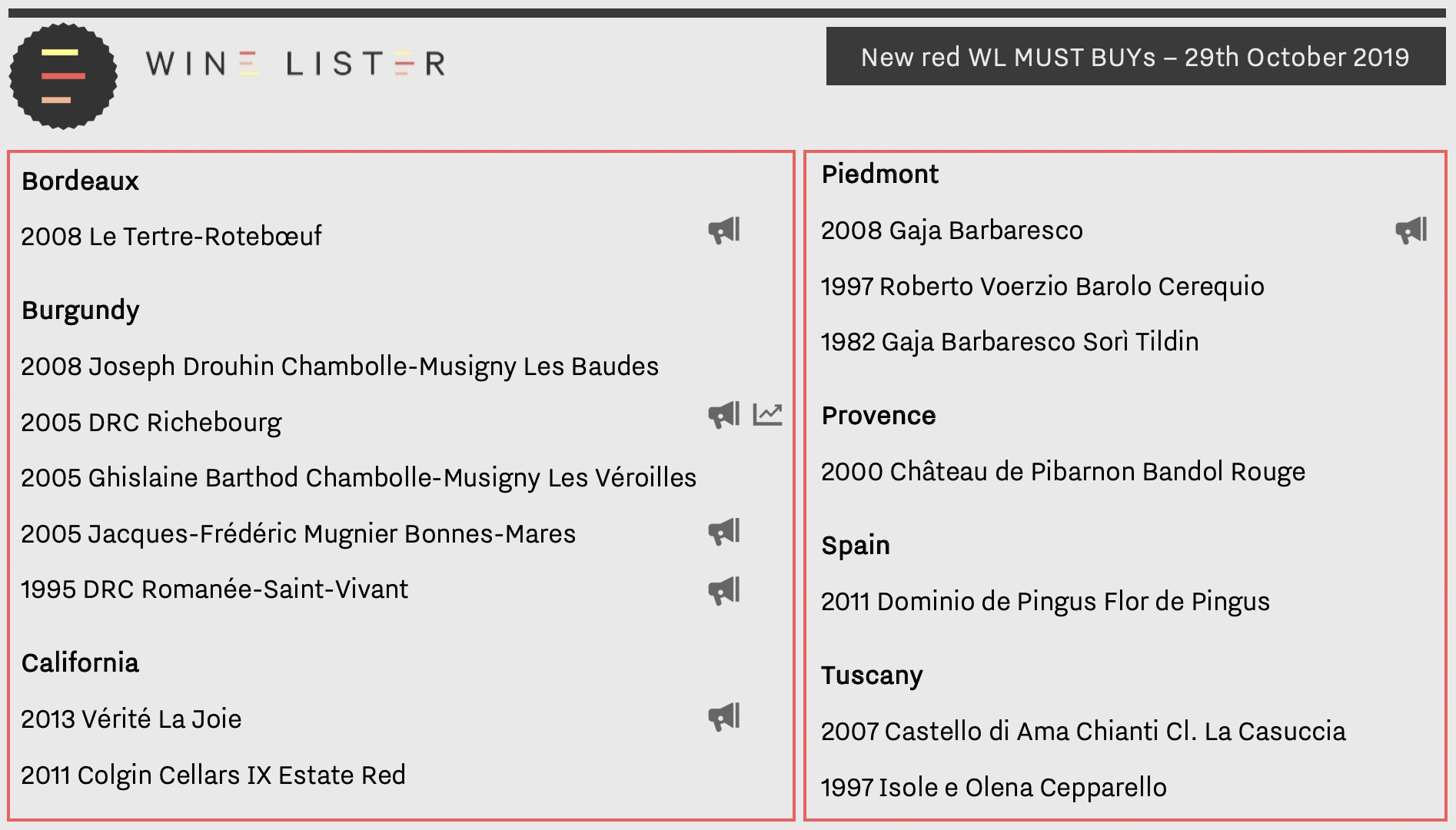
Bordeaux achieves just one entry in Le Tertre-Rotebœuf 2008 (one of nine Bordeaux 2008 MUST BUYs). California also makes its mark, with Vérité’s La Joie 2013 and Colgin Cellars IX Estate Red 2011. Outside of “classic” fine wine regions, Château de Pibarnon’s Bandol Rouge 2000 also enters the fray.
See the full list of current MUST BUYs here.
Last week we introduced Wine Lister’s new toy, a dynamic guide to the ultimate wines any fine wine lover should consider for their cellar – WL MUST BUY. While the full list is approximately 1,800 recommendations strong, Wine Lister provides some useful segments to help cut into all that data, aside from the usual criteria that can be found in our advanced search function (region, price, colour, score etc).
Wine Lister Indicators are designed to provide suggestions for your specific buying purpose, whether it be to discover something new (Hidden Gems), impress at a dinner party (Buzz Brands), drink well without breaking the bank (Value Picks), or add to your investment portfolio (Investment Staples).
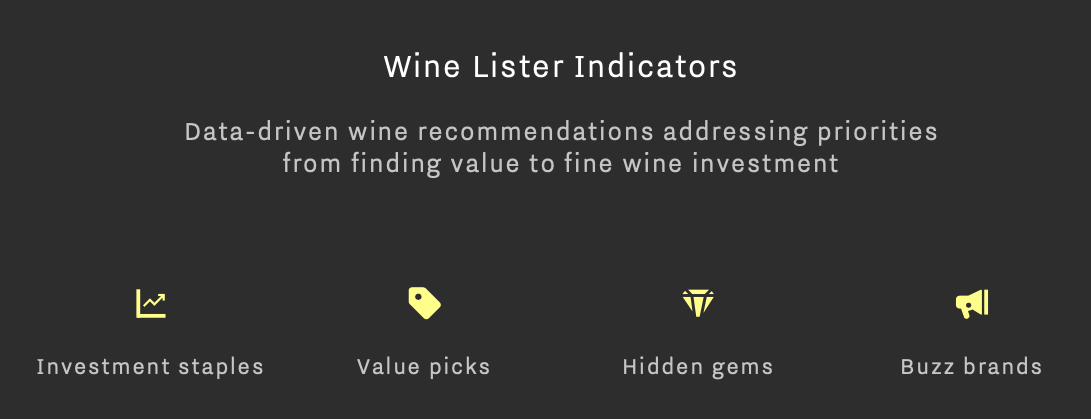
MUST BUYs and Indicators together provide a ready-made source list of the best wines to meet your needs. Below we look at the combination of our MUST BUY algorithm with Investment Staples.
Investment Staples are wines above a certain price, that are long-lived (but not too old), have proven wine price performance or represent good value compared to their peers, and are relatively stable and liquid, with recognition from our network of global fine wine trade members.
There are 18 MUST BUY Investment Staples that score 97 WL points or above. Perhaps unsurprisingly, Bordeaux represents almost half of these, with eight MUST BUYs, including two first growths (2016 Mouton, and 2016 Lafite), and 1975 Petrus.
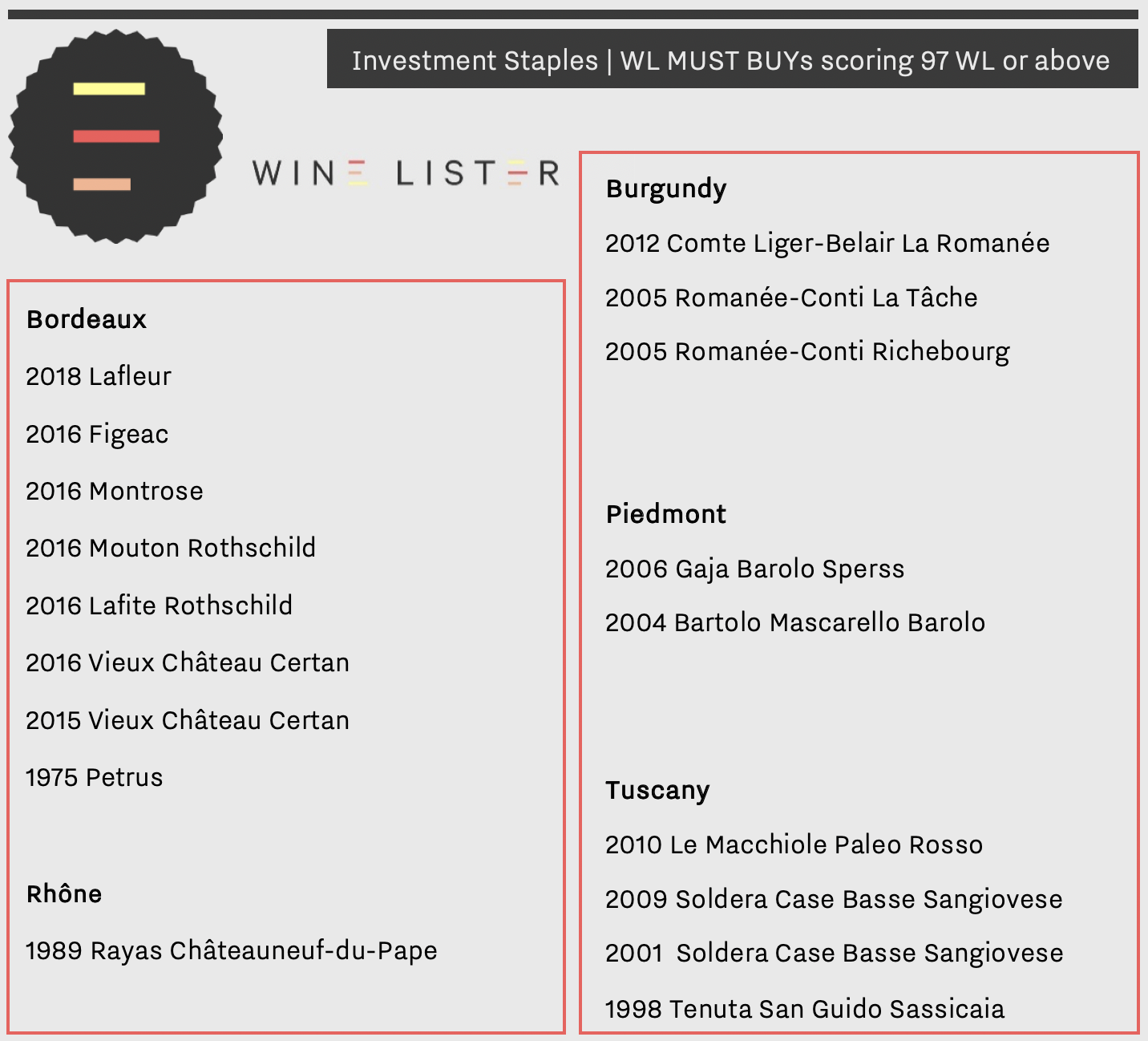
These eight Bordeaux have an average price of £511 per bottle, or just under an eighth of the average price of the three Burgundies to qualify as MUST BUY Investment Staples. However, as investments, some of them may require patience – the prices of those from 2016 have yet to increase any significant amount. By contrast, DRC’s La Tâche 2005, Richebourg 2005, and Comte Liger-Belair La Romanée 2012 are testament to Burgundy’s impressive upward price trajectory, having already achieved three-year CAGR (compound annual growth rates) of 21.8%, 23.4%, and 33.1% respectively.
Outside of Bordeaux and Burgundy, Italy holds court with MUST BUY Investment staples from Bartolo Mascarello, and the indomitable Soldera among others.
You can see the full list of MUST BUY Investment Staples here, or check out some other MUST BUY lists, such as MUST BUY Hidden Gems, or MUST BUY Value Picks.
Don’t forget that the MUST BUY list changes weekly. Revisit MUST BUY Investment Staples again next week to see new entries.
Wine Lister is excited to announce the arrival of its new consumer site, aimed at supporting fine wine lovers as they navigate the fine wine seas. All users now have unlimited, free access to the world’s most comprehensive fine wine data hub. Start learning how to buy wine like a pro now, or read on to find out more.
WL MUST BUYs
Wine Lister has created its own buy recommendation tool, which combines Wine Lister data with human intelligence (such as the opinion of key members of the global fine wine trade, plus insight from the Wine Lister team’s trips and tastings), to provide a dynamic list of wines any fine wine buyer should consider for their cellar. All MUST BUYs represent high quality, and value within their respective appellations and vintages.
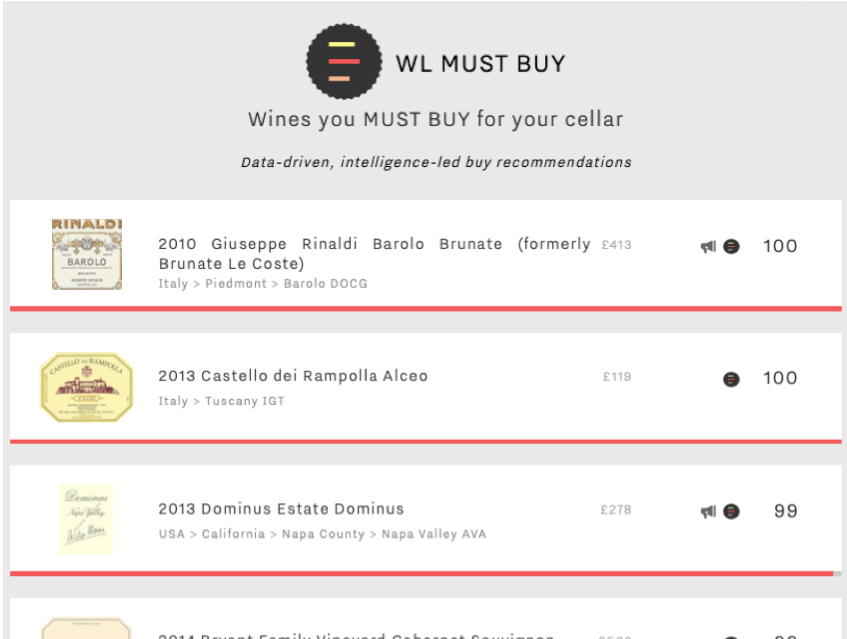 Browse the full MUST BUY list here.
Browse the full MUST BUY list here.
Aggregated, 100-point score
With a focus on quality, the new 100-point Wine Lister Score combines the ratings of five of the world’s most respected wine critics – Jancis Robinson, Antonio Galloni and Neal Martin (Vinous), Bettane+Desseauve, and Jeannie Cho Lee, together with a smaller weighting for the wine’s ageing potential. The score is as objective an indication of wine quality as possible, allowing users to make site-wide comparisons across the 30,000+ wine-vintages on Wine Lister.
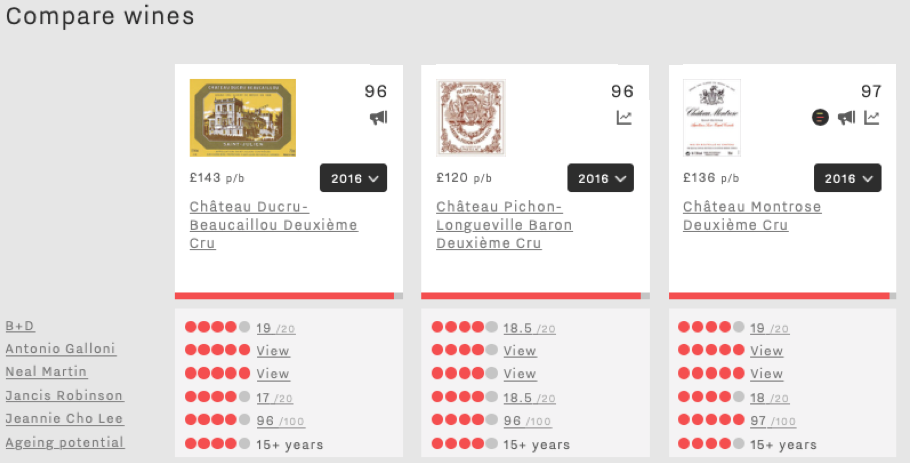
See this comparison, or create your own here.
Further analysis tools
Dynamic charts give users the chance to explore wines they might consider buying or selling in more detail.
The Vintage Value Identifier gives users a clear visual of price to quality ratios across vintages of a given wine, applying a score to this measure of relative value. See the example below for Mouton Rothschild: while the 2016 vintage is higher quality than 2014, its accompanying high price means that both the 2016 and 2014 vintages present the same level of value (the joint-highest of all recent back vintages shown)
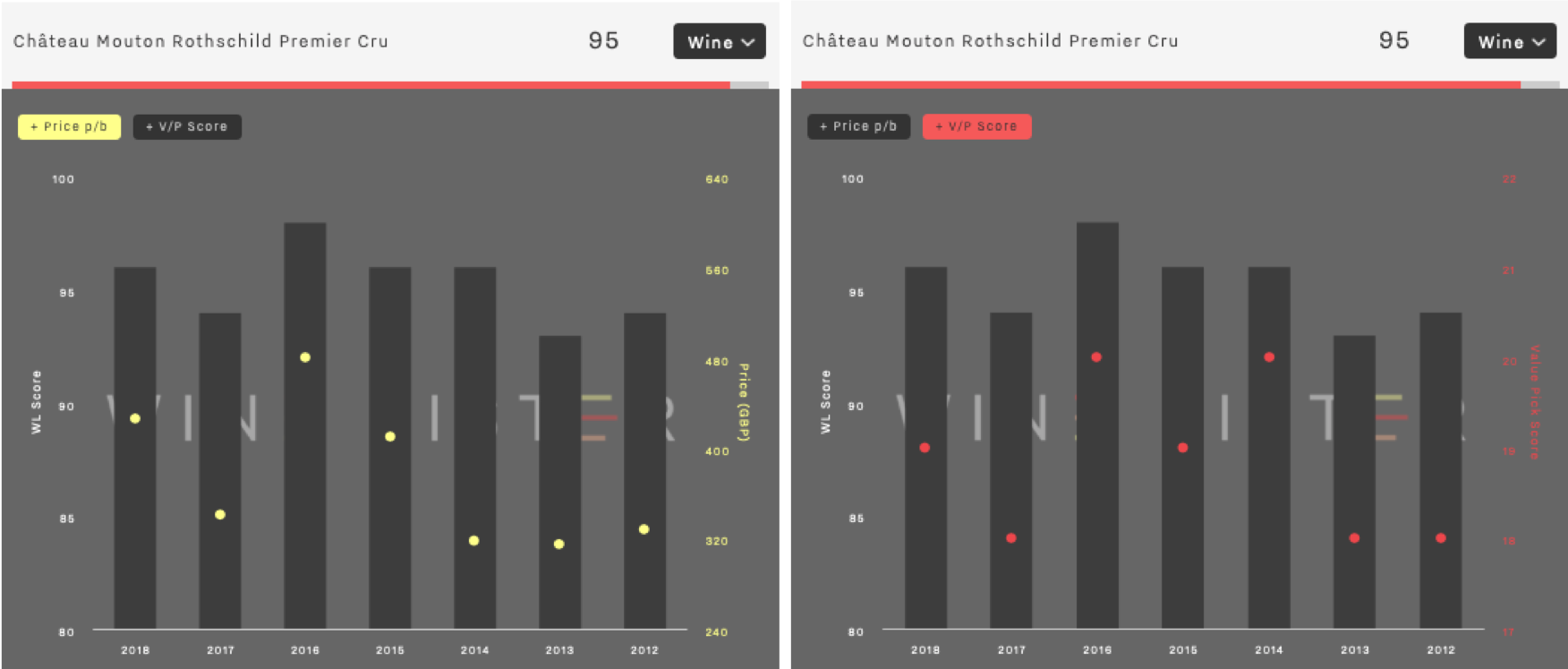 Wine Lister’s dynamic Vintage Value Identifier chart, showing price vs. quality (left) and Value Pick score (right).
Wine Lister’s dynamic Vintage Value Identifier chart, showing price vs. quality (left) and Value Pick score (right).
See the chart for Mouton Rothschild, or search for another wine here.
The Price History chart tracks a wine’s price performance over time, relative to its peer group. This can be done at vintage level, helping collectors to see performance history of a specific wine they might own. See below the example of Domaine Hubert Lignier’s Clos de La Roche 2016, whose price growth over the last year is one of the most impressive of all wines on Wine Lister (57.8%).
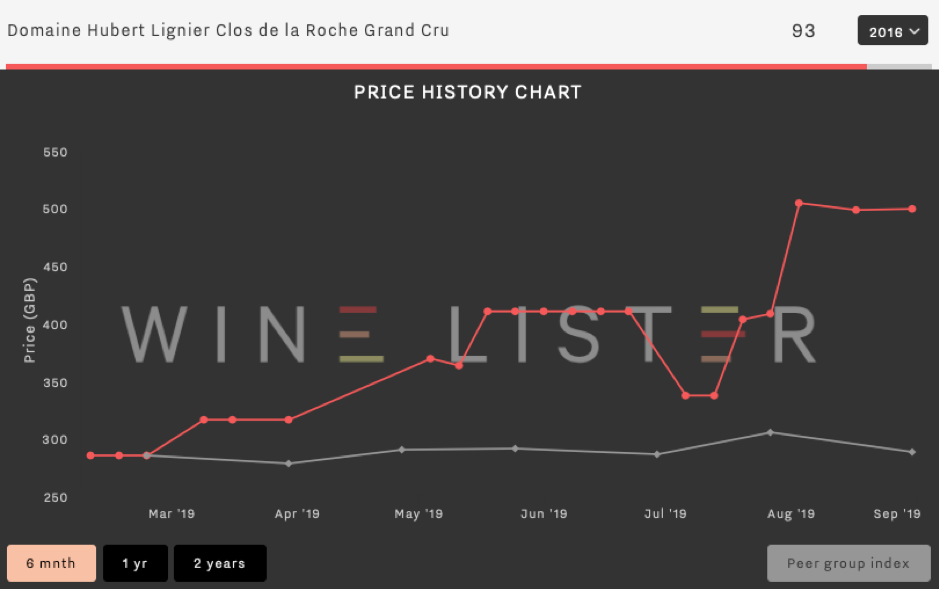 Hubert Lignier Clos de la Roche 2016’s six-month price performance compared to performance of other Clos de la Roche Grand Cru 2016s
Hubert Lignier Clos de la Roche 2016’s six-month price performance compared to performance of other Clos de la Roche Grand Cru 2016s
The same dynamic chart can be used at wine level (an average across vintages, with a stronger weighting for more recent vintages), to give a general indication of a wine’s price trajectory, and therefore whether or not the wine in question could be an investment buy. See below an example for Armand Rousseau’s Chambertin, which on average sees steady price growth, and a CAGR (compound annual growth rate) of 31.8% (though the price has flattened out this year).
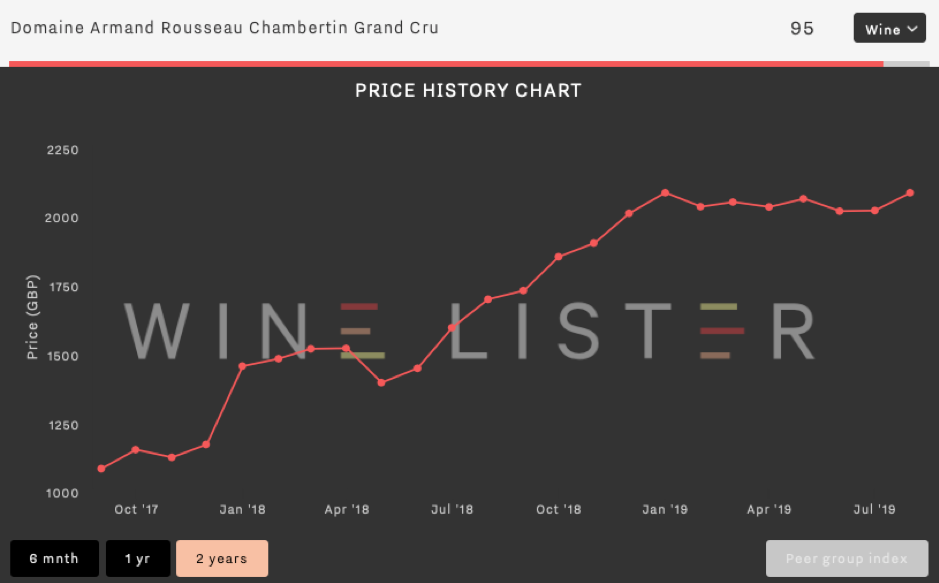 Armand Rousseau’s average price performance over two years
Armand Rousseau’s average price performance over two years
On top of these tools, each wine page gives users further information about the wine in question, including whether the wine qualifies for one of Wine Lister’s four Indicators. Haut Brion, as shown in the example below, is a Buzz Brand. See more information on other segments – Hidden Gems, Value Picks, and Investment Staples, or start browsing here.

We hope that you find the new site informative and useful for developing your fine wine collection. Feedback from our users is always welcome – please don’t hesitate to contact us with any questions or comments here.
The Bordeaux 2018 en primeur campaign is over. While the quality of wines available is, for the most part, unquestionably good, release prices have been on the high side to say the least, making the benefit of buying en primeur less obvious than in previous years.
Wine Lister’s brand-new website feature, WL MUST BUY, was launched this week*, especially for Bordeaux 2018 wines, to give valuable guidance as to which wines really are worth snapping up now.
Our ground-breaking MUST BUY recommendations are data-driven, with an intelligence-based, human overlay. The algorithm takes into account a wine’s quality and value within its vintage and appellation, as well as the latest industry intelligence from key players in the global fine wine trade. The Wine Lister team have scoured these results to identify must-buy wines based on our own tastings of Bordeaux 2018s, and insider market knowledge.
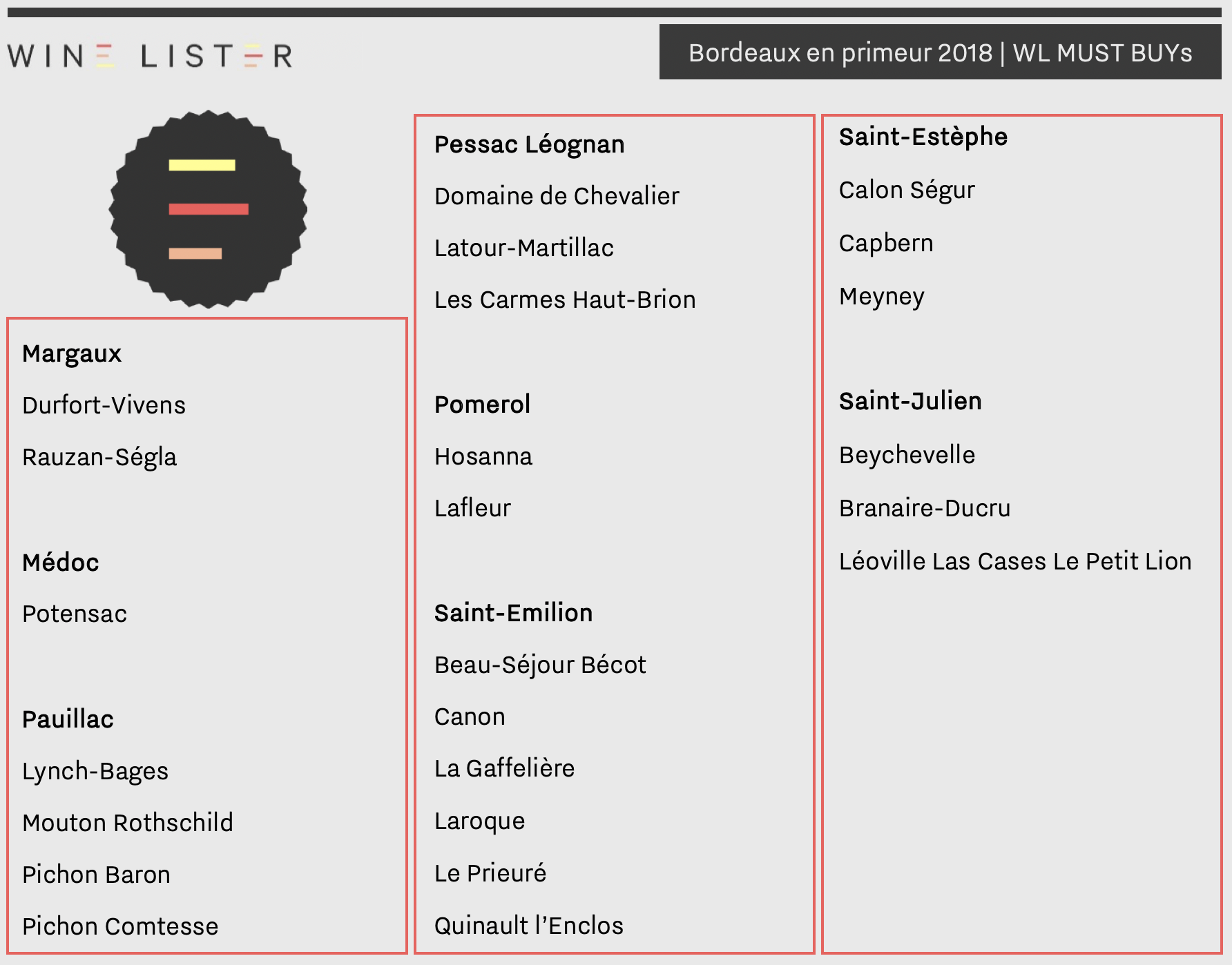
Given the dominance of reds in the top Bordeaux 2018 Quality scores, it is no surprise that all of these WL MUST BUYs are red.
Saint-Emilion ranks as our most recommended appellation, with six WL MUST BUYs, including the indomitable Canon, and value successes Le Prieuré, Quinault l’Enclos, and Laroque. These three achieve WL MUST BUY status by first passing the quality filter of Wine Lister’s MUST BUY algorithm (they exceed their collective Quality score average by 192 points in 2018). Their respective prices relative to similar quality 2018s from Saint-Emilion push them through the algorithm’s second step – the value filter. Finally, they have been identified by the fine wine trade and/or the Wine Lister team as wines to watch: Quinault l’Enclos is made by the elite winemaking team of Cheval Blanc, and their best yet, while Laroque has been taken to new heights by winemaker David Suire (who cut his teeth at Larcis-Ducasse).
Pauillac houses four of the “top end” Bordeaux 2018 MUST BUYs – Mouton (released at £426 per bottle in bond), both powerhouse super-seconds, Pichon Baron and Pichon Comtesse, and Buzz Brand Lynch Bages.
Sharing three picks apiece are further left bank appellations Saint-Julien, Saint-Estèphe, and Pessac-Léognan. Capbern, Meyney, and Latour-Martillac are testament to the value proposition available in Saint-Estèphe and Pessac-Léognan respectively. Saint-Julien MUST BUYs are represented by two fourth-growth staples, Branaire-Ducru and Beychevelle, and the second wine of Léoville Las Cases, Le Petit Lion.
Margaux earns two MUST BUYs – Rauzan-Ségla, and biodynamic Durfort Vivens (who made a huge step up in quality this year, and whose 2018 yield was less than a quarter of its usual volume). Pomerol equals this number with Lafleur and Hosanna.
Other wines featured in Wine Lister’s Bordeaux 2018 MUST BUYs list are: Beau-Séjour Bécot, Calon Ségur, Domaine de Chevalier Rouge, La Gaffelière, Les Carmes Haut-Brion, and Potensac.
*Wine Lister launched its MUST BUY tool on Monday at a Telegraph event entitled “Wine for Pleasure or Profit?”, where founder & CEO Ella Lister spoke about going “Back to Bordeaux” for both. You can see slides from the presentation relevant to Bordeaux 2018 MUST BUYs here: Telegraph Back to Bordeaux
Included in Part II of Wine Lister’s Bordeaux Study 2019 (released last week), are results of our latest trade survey. Wine Lister asks its Founding Members (c.50 key players in the global fine wine trade) to give “confidence” ratings to more than 100 key Bordeaux wines on a scale of 0 to 10; 0 being zero confidence.
For the third consecutive year, no Bordeaux wine received a perfect 10/10. Wines retaining their 9/10 confidence rating since last year are Le Pin, Margaux, Mouton, and Petrus. Joining them in 2019 are Lafleur, Latour, and Vieux Châteaux Certan – the latter being a particular source of interest, given its average price of £139, or just 13% of the average of the rest of the group.
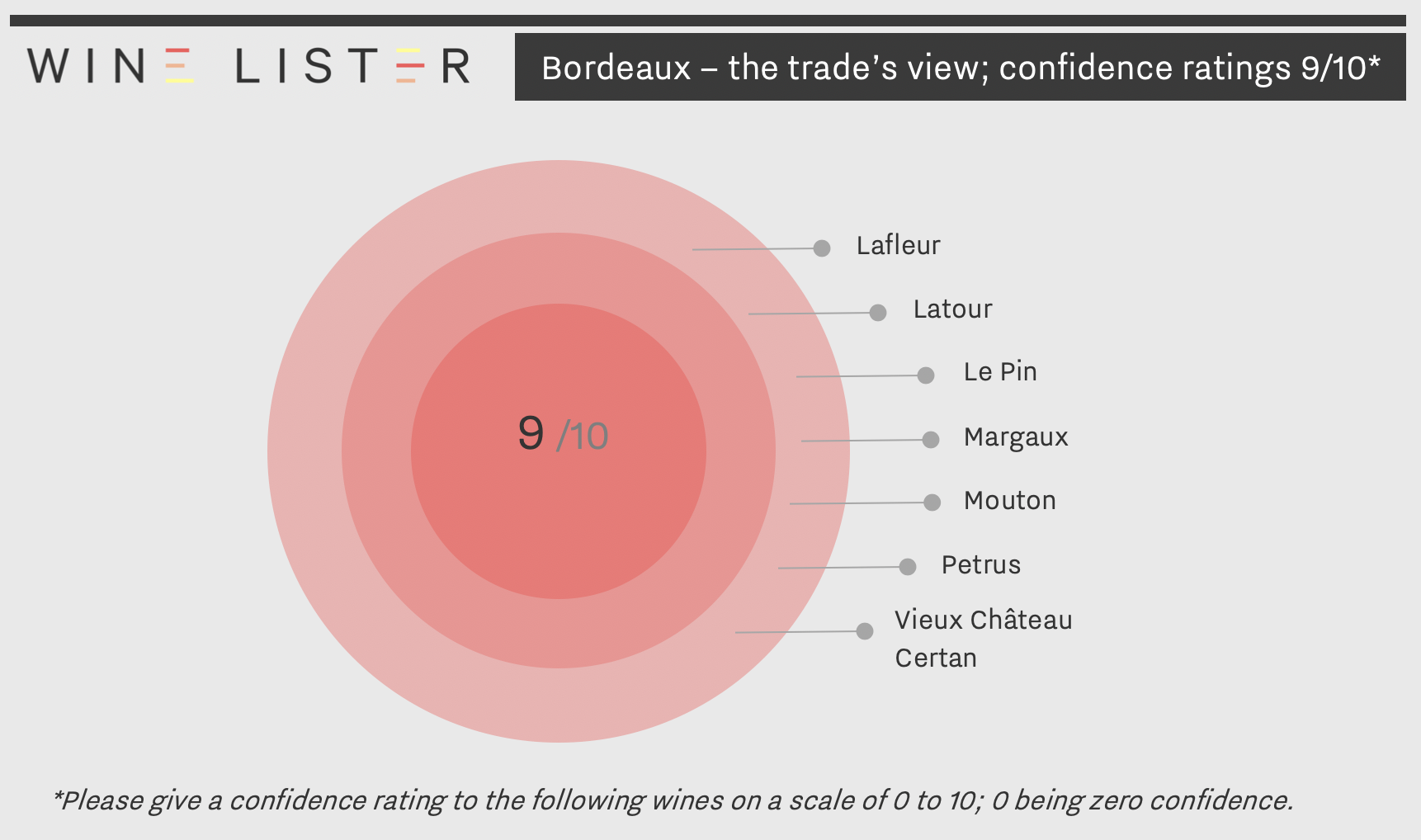
Meanwhile the two remaining left bank first growths, Haut-Brion and Lafite, have slipped down into the next confidence band, receiving an average of 8/10. Saint-Émilion superstar, Canon, has also moved down one point since last year, despite also being cited by the same trade group as a wine seeing the sharpest rise in demand, and a wine of likely future prestige.
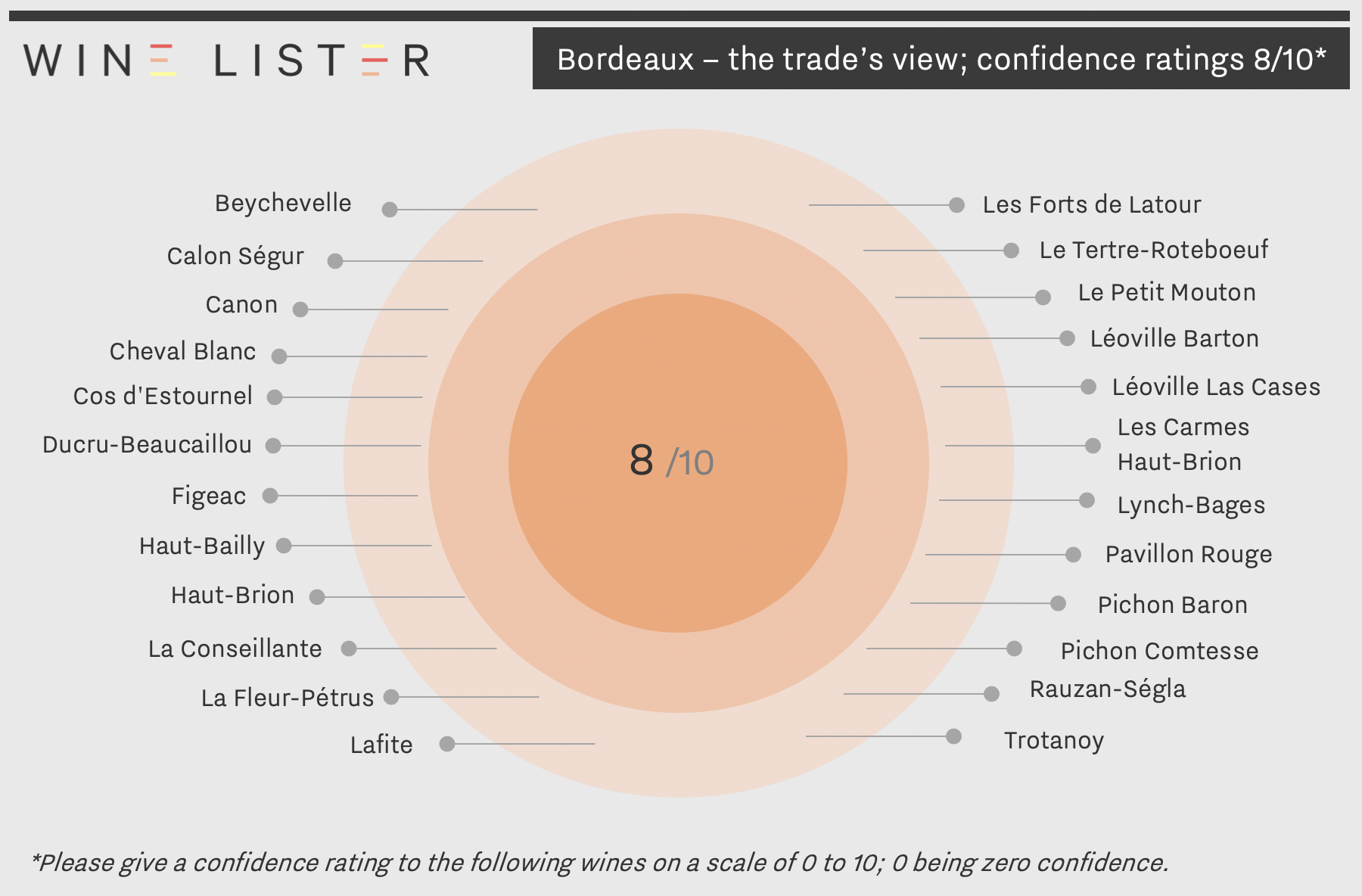
The 8/10 category contains 24 wines, compared with 21 in 2018. New entries into the 8/10 category include two of the best performers en primeur – Beychevelle and Les Carmes Haut-Brion. Others moving up to this category are Cos d’Estournel, Les Forts de Latour, and Léoville Barton.
The improved confidence in Pomerol within the top two groups is noticeable, with Lafleur and Vieux Château Certan effectively taking the places of Canon and Lafite, and two wines from the Moueix stable – La Fleur-Pétrus and Trotanoy moving up into the 8/10 category this year (at the expense of Ausone, La Mission Haut-Brion, Léoville Poyferré, Montrose, and Palmer, which have all moved down into the 7/10 group). As well as earning high confidence, Pomerol also achieves the highest number of wines in the 2018 Quality top-25.
Visit Wine Lister’s Analysis page to buy and/or download the full report, and see confidence ratings for all other wines in the study (available in both English and French).










 Browse the full MUST BUY list
Browse the full MUST BUY list 
 Wine Lister’s dynamic Vintage Value Identifier chart, showing price vs. quality (left) and Value Pick score (right).
Wine Lister’s dynamic Vintage Value Identifier chart, showing price vs. quality (left) and Value Pick score (right). Hubert Lignier Clos de la Roche 2016’s six-month price performance compared to performance of other Clos de la Roche Grand Cru 2016s
Hubert Lignier Clos de la Roche 2016’s six-month price performance compared to performance of other Clos de la Roche Grand Cru 2016s Armand Rousseau’s average price performance over two years
Armand Rousseau’s average price performance over two years 


